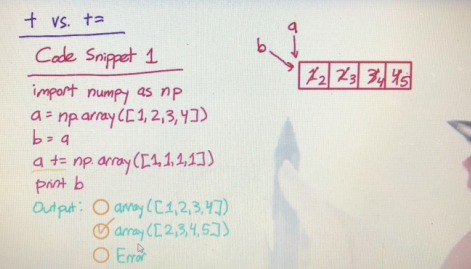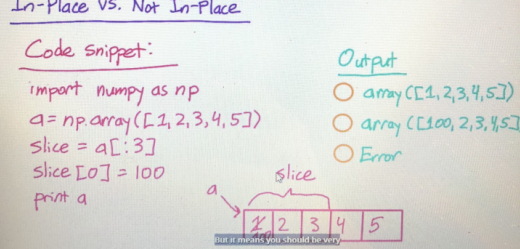1.Numpy数组
numpy的数组只能存放同一种数据类型,使用的方式和Python列表类似
1.1 声明:

1 import numpy as np 2 countries = np.array([ 3 'Afghanistan', 'Albania', 'Algeria', 'Angola', 'Argentina', 4 'Armenia', 'Australia', 'Austria', 'Azerbaijan', 'Bahamas', 5 'Bahrain', 'Bangladesh', 'Barbados', 'Belarus', 'Belgium', 6 'Belize', 'Benin', 'Bhutan', 'Bolivia', 7 'Bosnia and Herzegovina' 8 ]) 9 employment = np.array([ 10 55.70000076, 51.40000153, 50.5 , 75.69999695, 11 58.40000153, 40.09999847, 61.5 , 57.09999847, 12 60.90000153, 66.59999847, 60.40000153, 68.09999847, 13 66.90000153, 53.40000153, 48.59999847, 56.79999924, 14 71.59999847, 58.40000153, 70.40000153, 41.20000076 15 ])
1.2 获取&切片

1 print countries[0] 2 print countries[3] 3 4 print countries[0:3] 5 print countries[3:] 6 print countries[17] 7 print countries[:]
1.3 for循环

1 for i in range(len(countries)): 2 country = countries[i] 3 country_employeement = employment[i] 4 print 'Country {} has employeement {}'.format(country,country_employeement)
1.4 数据类型

1 print countries.dtype 2 print employment.dtype 3 print np.array([0, 1, 2, 3]).dtype 4 print np.array([1.0, 1.5, 2.0, 2.5]).dtype 5 print np.array([True, False, True]).dtype 6 print np.array(['AL', 'AK', 'AZ', 'AR', 'CA']).dtype
1.5 计算统计值

1 print employment.mean() 2 print employment.std() 3 print employment.max() 4 print employment.min()
1.6 获取具有最多就业率的国家

1 def max_employeement(countries,employment): 2 i = employment.argmax() 3 return (countries[i],employment[i])
1.7 numpy向量与向量运算

1 #1.两个numpy向量的数值运算 2 a=np.array([1,2,3,4]) 3 b=np.array([1,2,1,2]) 4 5 #依次相加,符合线性代数的向量加法 6 print a+b 7 print a-b 8 print a*b 9 print a/b 10 print a**b
1.8 向量与值的运算

1 #符合线性代数的运算规则 2 a=np.array([1,2,3,4]) 3 b=2 4 print a+b 5 print a-b 6 print a*b 7 print a/b 8 print a**b
1.9 向量的逻辑运算

1 a=np.array([True,True,False,False]) 2 b=np.array([True,False,True,False]) 3 4 #每一个值依次比较 5 print a&b 6 print a|b 7 print ~a 8 9 print a&True 10 print a&False 11 12 print a|True 13 print b|False
1.10 向量之间的比较

1 a = np.array([1, 2, 3, 4, 5]) 2 b = np.array([5, 4, 3, 2, 1]) 3 #每一个值依次比较 4 print a > b 5 print a >= b 6 print a < b 7 print a <= b 8 print a == b 9 print a != b
1.11 向量和数值比较

1 a=np.array([1,2,3,4]) 2 b=2 3 #a向量的每一个值都和b比较,返回True or False 4 print a > b 5 print a >= b 6 print a < b 7 print a <= b 8 print a == b 9 print a != b
1.12 向量之间可以直接进行相加在进行别的运算

1 female_completion = np.array([ 2 97.35583, 104.62379, 103.02998, 95.14321, 103.69019, 3 98.49185, 100.88828, 95.43974, 92.11484, 91.54804, 4 95.98029, 98.22902, 96.12179, 119.28105, 97.84627, 5 29.07386, 38.41644, 90.70509, 51.7478 , 95.45072 6 ]) 7 8 # Male school completion rate in 2007 for those 20 countries 9 male_completion = np.array([ 10 95.47622, 100.66476, 99.7926 , 91.48936, 103.22096, 11 97.80458, 103.81398, 88.11736, 93.55611, 87.76347, 12 102.45714, 98.73953, 92.22388, 115.3892 , 98.70502, 13 37.00692, 45.39401, 91.22084, 62.42028, 90.66958 14 ]) 15 16 #求和取出两个向量的总体的均值 17 def overall_completion_rate(female_completion, male_completion): 18 return (female_completion+male_completion)/2
1.13 获取特定值的标准差

1 country_name = 'United States' 2 def standardize_data(values): 3 #直接将一组数据进行加工,得出一组结果集 4 standardized_values = (values-values.mean())/values.std() 5 return standardized_values
1.14 numpy的索引向量

1 a=np.array([1,2,3,4]) 2 b=np.array([True,True,False,False]) 3 4 #返回b中为True的索引所对应的值 5 print a[b] 6 print a[np.array([True,False,True,False])]
1.15 numpy索引向量可以支持表达式

1 a=np.array([1,2,3,2,1]) 2 b=(a>=2) 3 4 print a[b] 5 #返回boolen向量 6 print a[a>=2]
1.16 numpy可返回索引向量

1 a = np.array([1,2,3,4,5]) 2 b = np.array([1,2,3,2,1]) 3 #返回索引向量 4 print b == 2 5 print a[b==2]
1.17 计算每周学习时间的平均数

1 time_spent = np.array([ 2 12.89697233, 0. , 64.55043217, 0. , 3 24.2315615 , 39.991625 , 0. , 0. , 4 147.20683783, 0. , 0. , 0. , 5 45.18261617, 157.60454283, 133.2434615 , 52.85000767, 6 0. , 54.9204785 , 26.78142417, 0. 7 ]) 8 9 # Days to cancel for 20 students 10 days_to_cancel = np.array([ 11 4, 5, 37, 3, 12, 4, 35, 38, 5, 37, 3, 3, 68, 12 38, 98, 2, 249, 2, 127, 35 13 ]) 14 15 #计算出每周学习时间的平均数 16 def mean_time_for_paid_students(time_spent, days_to_cancel): 17 return time_spent[days_to_cancel>=7].mean()
2.Pandas数组
pandas数组是在numpy的数组上做了一次封装,可以支持更多的统计分析功能,而且也具有和Python字典类似的功能,key的值可以是任意类型
2.1 pandas数组常用功能

1 import pandas as pd 2 life_expectancy_values = [74.7, 75. , 83.4, 57.6, 74.6, 75.4, 72.3, 81.5, 80.2, 3 70.3, 72.1, 76.4, 68.1, 75.2, 69.8, 79.4, 70.8, 62.7, 4 67.3, 70.6] 5 6 gdp_values = [ 1681.61390973, 2155.48523109, 21495.80508273, 562.98768478, 7 13495.1274663 , 9388.68852258, 1424.19056199, 24765.54890176, 8 27036.48733192, 1945.63754911, 21721.61840978, 13373.21993972, 9 483.97086804, 9783.98417323, 2253.46411147, 25034.66692293, 10 3680.91642923, 366.04496652, 1175.92638695, 1132.21387981] 11 12 #转换成pandas数组 13 life_expectancy = pd.Series(life_expectancy_values) 14 gdp = pd.Series(gdp_values) 15 16 #切片 17 print life_expectancy[0] 18 print gdp[3:6] 19 20 #循环 21 for country_life_expectancy in life_expectancy: 22 print 'Examining life expectancy {} '.format(country_life_expectancy) 23 24 #统计函数 25 print life_expectancy.mean() 26 print life_expectancy.std() 27 print gdp.max() 28 print gdp.sum()
2.2 pandas数组向量运算

1 a = pd.Series([1, 2, 3, 4]) 2 b = pd.Series([1, 2, 1, 2]) 3 4 print a+b 5 print a*2 6 print a>=3 7 print a[a>=3]
2.3 获取寿命和gdp的关系

1 #获取gdp和寿命的关系 2 def variable_correlation(variable1, variable2): 3 #获取所有超过平均值和小于平均值的v1和v2 4 both_above = (variable1>variable1.mean()) & (variable2>variable2.mean()) 5 both_below = (variable1<variable1.mean()) & (variable2<variable2.mean()) 6 #获取处于同向的数据 7 is_same_direction = both_above|both_below 8 #统计出True的值 9 num_same_direction = is_same_direction.sum() 10 num_different_direction = len(variable1)-num_same_direction 11 return (num_same_direction,num_different_direction)
说明:大部分数据的方向相同,说明两个变量是正相关的(一个值较大,另一个值也大)
如果第一个数字较小,第二个数字较大,说明变量是负相关的
如果两个变量的值相等说明.这两个变量无关
2.4 pandas数组索引访问

1 countries = [ 2 'Afghanistan', 'Albania', 'Algeria', 'Angola', 3 'Argentina', 'Armenia', 'Australia', 'Austria', 4 'Azerbaijan', 'Bahamas', 'Bahrain', 'Bangladesh', 5 'Barbados', 'Belarus', 'Belgium', 'Belize', 6 'Benin', 'Bhutan', 'Bolivia', 'Bosnia and Herzegovina', 7 ] 8 9 10 employment_values = [ 11 55.70000076, 51.40000153, 50.5 , 75.69999695, 12 58.40000153, 40.09999847, 61.5 , 57.09999847, 13 60.90000153, 66.59999847, 60.40000153, 68.09999847, 14 66.90000153, 53.40000153, 48.59999847, 56.79999924, 15 71.59999847, 58.40000153, 70.40000153, 41.20000076, 16 ] 17 18 #转换成pandas数组,值为employment,索引是countries 19 employment = pd.Series(employment_values,index=countries) 20 21 #找出工资最高的国家 22 def max_employment(employment): 23 #获取empolyment中最大的索引,然后根据索引取值 24 max_country = employment.argmax() 25 max_value = employment.loc[max_country] 26 return (max_country,max_value)
2.5 去除NaN值

1 #会根据关键字来赋值而不是位置来赋值,和python的关键字参数同理 2 s1=pd.Series([1,2,3,4],index=['a','b','c','d']) 3 s2=pd.Series([10,20,30,40],index=['a','b','c','d']) 4 print s1+s2 5 6 s1=pd.Series([1,2,3,4],index=['a','b','c','d']) 7 s2=pd.Series([10,20,30,40],index=['b','d','a','c']) 8 print s1+s2

1 #此时由于关键字参数缺失,会出现NaN值的情况 2 s1=pd.Series([1,2,3,4],index=['a','b','c','d']) 3 s2=pd.Series([10,20,30,40],index=['c','d','e','f']) 4 print s1+s2 5 6 s1=pd.Series([1,2,3,4],index=['a','b','c','d']) 7 s2=pd.Series([10,20,30,40],index=['e','f','g','h']) 8 print s1+s2 9 10 #直接填充默认值来处理NaN值,这样NaN值会显示原来的值 11 s1.add(s2,fill_value=0)
2.6 自定义方法,可以执行pandas中没有的逻辑

1 #自定义方法apply 2 names = pd.Series([ 3 'Andre Agassi', 4 'Barry Bonds', 5 'Christopher Columbus', 6 'Daniel Defoe', 7 'Emilio Estevez', 8 'Fred Flintstone', 9 'Greta Garbo', 10 'Humbert Humbert', 11 'Ivan Ilych', 12 'James Joyce', 13 'Keira Knightley', 14 'Lois Lane', 15 'Mike Myers', 16 'Nick Nolte', 17 'Ozzy Osbourne', 18 'Pablo Picasso', 19 'Quirinus Quirrell', 20 'Rachael Ray', 21 'Susan Sarandon', 22 'Tina Turner', 23 'Ugueth Urbina', 24 'Vince Vaughn', 25 'Woodrow Wilson', 26 'Yoji Yamada', 27 'Zinedine Zidane' 28 ]) 29 #将姓名翻转 30 def reverse_name(name): 31 split_name = name.split(' ') 32 first_name = split_name[0] 33 last_name = split_name[1] 34 return last_name + ', ' +first_name 35 36 #直接通过apply即可调用 37 def reverse_names(names): 38 return names.apply(reverse_name)
2.7 使用pandas画图

1 %pylab inline 2 #读取csv文件 3 employment = pd.read_csv('employment-above-15.csv',index_col='Country') 4 #根据index获取value 5 employment_us = employment.loc['United States'] 6 #画散点图 7 employment_us.plot()
3 注意事项:
在numpy数组中,要注意+=,和+的区别
3.1 +=
+=是在原有的数组上进行修改,因为a,b共享一块内存,所以a修改会导致b也修改

1 import numpy as np 2 a = np.array([1,2,3,4]) 3 b = a 4 a+=np.array([1,1,1,1]) 5 print b 6 7 #因为a,b用的是同一块内存,当a的值改变b的值就会改变 8 #2,3,4,5

3.2 +
+表示a数组重新开辟了一块内存空间存放新的数组,本质上a,b是占用两个不同的内存空间

1 import numpy as np 2 a = np.array([1,2,3,4]) 3 b=a 4 a = a + np.array([1,1,1,1]) 5 print b 6 7 #此时a,b用的是两块独立的内存空间,所以b的值还是1,2,3,4

3.3 切片
切片出来的子集是原先数组的视图,与原数组共享一块内存空间,所以会连带修改

1 import numpy as np 2 a = np.array([1,2,3,4,5]) 3 slice = a[:3] 4 slice[0] = 100 5 print slice 6 7 #因为切片出来的数据还是原先数据的镜像,所以一旦修改原数据也会修改 8 #100,2,3

